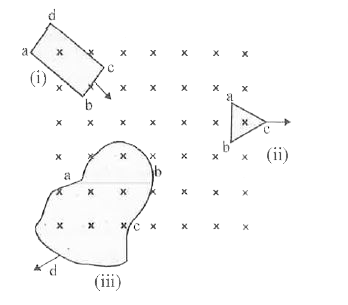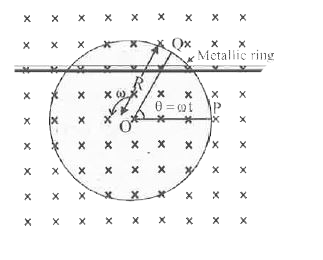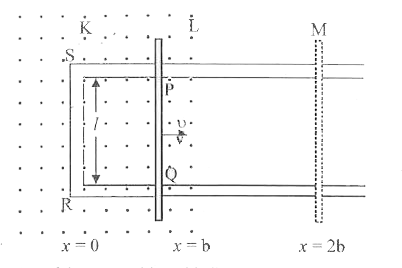Complete Solutions to EXAMPLES of chapter ELECTROMAGNETIC INDUCTION of Class 12 book with complete answers and questions
| Class 12 | PHYSICS |
| Chapter | ELECTROMAGNETIC INDUCTION |
| NCERT TAMIL | EXAMPLES |
| Number Of Questions | 11 |
| Academic Year | 2023-24 |
Consider Experiment II in Section 6.2.
a. What would you do to obtain a large deflection of the galvanometer?
b. How would you demonstrate the presence of an induced current in the absence of a galvanometer?
View SolutionA square loop of side 10 cm and resistance 0.5 `Omega` is placed vertically in the east-west plane. A uniform magnetic field of 0.10 T is set up across the plane in the north-east direction. The magnetic field is decreased to zero in 0.70 s at a steady rate. Determine the magnitudes of induced emf and current during this time-interval.
View SolutionA circular coil of radius 10 cm, 500 turns and resistance 2 Omega is placed with its plane prependicular to the horizontal component of the earth's magnetic field. It is rotated about its vertical diameter through `180^(@)` in 0.25 s. Estimate the magnitude of the e.m.f and current induced in the coil. Horizotal component of earth's magnetic field at the place is `3 xx 10^(-5) T`.
View SolutionFigure shows planar loops of different shapes moving out of or into a region of a magnetic field which is directed normal to the plane of the loop away from the reader. Determine the direction of induced current in each loop using Lenz's law.

View Solutiona. A closed loop is held stationary int eh magnetic field between the north and south poles of two permanent magnets held fixed. Can we hope to generate current in the loop by using very strong magnets?
b. A closed loop move normal to the constant electric field between the plates of a large capacitor. Is a current induced in the loop (i) when it is wholly inside the region between the capacitor plates (ii) when it is partially outside the plates of the capacitor? The electric field is normal to the plane of the loop.
c. A rectangular loop and a circular loop are moving out of a uniform magnetic field (region). (see fig.) to field-free region with a constant velocity v. In which loop do you expect the induced emf to be constant during the passage out of the field region? The field is normal to the loops.

d. Predict the polarity of the capacitor in the situation described by the figure below.

View SolutionA metallic rod of 1m length is rotated with a frequency of 50 rev/s, with one end hinged at the centre and the other end at the circumference of a circular me tallic ring of radius 1m, about an axis passing through the centre and perpendicular to the plane of the ring (see figure). A constant and uniform magnetic field of 1T parallel to the axis present everywhere. What is the emf between the centre and the metallic ring?

View SolutionA wheel with 10 metallic spokes each 0.5 m long is rotated with a speed of 120 rev/min in a plane normal to the horizontal component of earth's magnetic field `H_E` at a place. If `H_E` 0.4 G at the place, what is the induced emf between the axle and the rim of the wheel ? Note that `1G =10^(-4)T.`
View SolutionThe arm PQ of the rectangular conductor is moved from `x=0`, outwards. The uniform magnetic field is perpendicular to the plane and extends from `x=0` to `x=b` and is zero for `xgtb`. Only the arm. PQ possesses substantial resistance r. Consider the situation when the arm PQ is pulled outwards from `x=0` to `x=2b`, and is then moved back to `x=0` with constant speed v. Obtain expressions for the flux, the induced emf, the force necessary to pull the arm and the power dissipated as Joule heat. Sketch the variation of these quantities with distance.

View SolutionTwo concentric circular coil,s one of small radius `r_(1)` and the other of large radius `r_(2)`, such that `r_(1) lt lt r_(2)`, are placed co-axially with centres coinciding. Obtain the mutual inductance of the arrangement.
View Solution(a) Obtain the expression for the magnetic energy stored in a solenoid in terms of magnetic field B, area A and length l of the solenoid. (b) How does this magnetic energy compare with the electrostatic energy stored in a capacitor?
View SolutionSuppose the loop in Exercies.4 is stationary but the current feeding the electromagnetic net that produces the magnetic field is gradually reduced so that the field decreases from its initial value of 0.3 T at the rate of 0.02 T `s^(-1)`. If the cut is joined and the loop has a resistance of `1.6Omega`, how much power is dissipated by the loop as heat? What is the source of this power?
View Solution
EXAMPLES questions and complete solutions for chapter ELECTROMAGNETIC INDUCTION of FULL MARKS PHYSICS(TAMIL) of Class 12